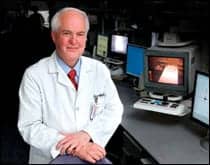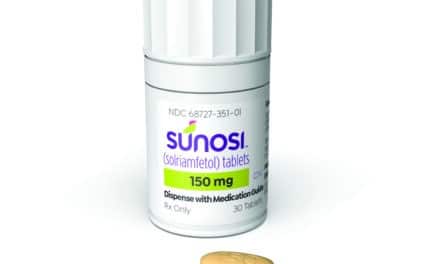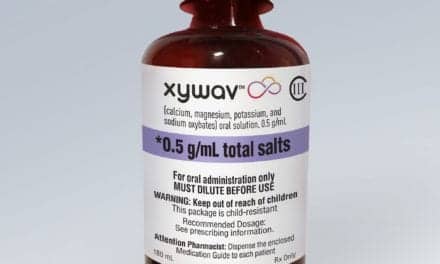 |
Narcolepsy is a neurological sleep disorder that can occur at any age. The major daytime symptoms include excessive daytime sleepiness (EDS) and cataplexy. EDS is characterized by daytime sleep attacks that are frequently uncontrollable and may occur with or without warning. These may continue for prolonged periods or be characterized by brief moments of intrusion of sleep into wakefulness. The potential impact includes impaired learning and predisposition to accidents. Cataplexy is characterized by a sudden loss of bilateral voluntary muscle control, which can be generalized (ie, involving many muscles and resulting in the person falling to the ground) or partial (ie, involving selective muscle groups and resulting in the person dropping objects, nodding the head forward, or buckling the knees). Respiratory muscles are unaffected. The most common areas involved in partial cataplexy are the knees, face, and neck.
Cataplexy is frequently triggered by strong positive emotions of which amusement strong enough to bring on laughter (such as when the person hears a joke) seems the most likely to bring on an attack. However, pride, elation, and surprise also can trigger the condition. Negative emotions, such as anger, may occasionally bring on cataplexy. The duration of cataplexy is usually brief, ranging from a few seconds to a few minutes. The consequences of cataplexy may include accidents and embarrassment.1
 |
Features associated with narcolepsy include sleep paralysis and hypnagogic hallucinations. Sleep paralysis is characterized by transient, generalized inability to move or speak during the transition between sleep and wakefulness. Hypnagogic hallucinations are vivid perceptual experiences occurring at sleep onset, often with the perception of the presence of someone or something, and include visual, auditory, and tactile sensations. Hypnopompic hallucinations are of similar character but occur at sleep-to-wake transitions. These are scary experiences associated with fear or dread. Sleep paralysis and hallucination symptoms occur in 40% to 80% of individuals with narcolepsy, but are not specific for narcolepsy and may occur in individuals who are otherwise asymptomatic or who have other sleep problems. Nocturnal sleep disruption occurs in as many as half of individuals with narcolepsy. This problem is primarily characterized by sleep maintenance problems rather than sleep-onset insomnia. Other sleep problems occur in a greater than expected frequency. These include REM-sleep-behavior disorder. An increased body mass index (BMI) and obesity are reported in many individuals with narcolepsy and may put them at risk for developing obstructive sleep apnea.1-2
The risk of having narcolepsy is likely related to both genetic and nongenetic factors. There is a low prevalence of familial cases of narcolepsy. The risk of a first-degree relative developing narcolepsy with cataplexy is approximately 1% to 2%. This represents a 10-fold to 40-fold increase over the general population. There is an association with the human leukocyte antigen (HLA) subtype DQB1*0602 and narcolepsy. Almost all individuals with narcolepsy and cataplexy are positive for this HLA subtype compared to 12% to 38% of the general population who have this HLA subtype. However, researchers do not believe DQB1*0602 is sufficient in itself for the development of narcolepsy. Studies of monozygotic twin pairs found only 29% concordant for this HLA subtype. Most people with this HLA subtype do not have and never will develop narcolepsy. Other genetic and/or environmental factors may be important to the development of narcolepsy.3
Studies of both genetically engineered and naturally occurring animal models of narcolepsy suggest that the disorder results from the selective loss of cells in the lateral hypothalamus that secrete the neurotransmitter hypocretin or orexin. These experiments indicate that the symptoms of narcolepsy may not appear until a critical number of hypocretin-producing cells are lost and the remaining cells may compensate for this loss by increasing their output. Cerebrospinal fluid (CSF) hypocretin levels are low in most but not all individuals with narcolepsy and cataplexy, and are normal in most but not all individuals with narcolepsy without cataplexy. These findings are helpful in understanding the onset of the symptoms of narcolepsy in late childhood and early adolescence in many individuals, as well as explaining the potential delay in diagnosis and initiating of treatment until that critical loss has been achieved.
The prevalence of narcolepsy with cataplexy falls between 25 and 50 per 1,000,000 (frequently noted as 1 in 2,000 people), while narcolepsy without cataplexy is 56 per 100,000 people.3 A case series suggested a bimodal distribution of onset with the first peak around age 15 years and a second peak at age 35 years.4 This was not demonstrated in another study, though this study did indicate the not uncommon onset of narcolepsy in childhood or adolescence. It reported a median age of onset of 16 years with a range of 4 to 56 years. Of the study group, 25% had onset by 12.5 years.5
Clearly, children and adolescents experience narcolepsy and most initially experience EDS rather than cataplexy. However, there are exceptions and many experience cataplexy as the major debilitating symptom. While individuals with narcolepsy can expect a normal life span, narcolepsy is a lifelong disorder for which there is no cure. It is not surprising that narcolepsy has a significant and often very negative impact on the lives of children with this disorder and their families. These children and adolescents are at high risk for school failure and social isolation. They may experience other medical problems such as obesity, type II diabetes, sleep apnea, and depression, which further contribute to poor quality of life for themselves and their families. The diagnosis may be delayed by the perception that the child is lazy, faking it, or using drugs, and/or has another diagnosis such as attention-deficit disorder. New pharmacological treatments with lower risks of adverse side effects and higher efficacy have been developed and approved for adults. For children, there is a lack of controlled treatment trials demonstrating efficacy and safety. These are challenges to the optimal care of children and adolescents with narcolepsy.
Diagnosis
In the second edition of The International Classification of Sleep Disorders,1 criteria are presented to define narcolepsy with cataplexy, narcolepsy without cataplexy, and narcolepsy due to another underlying medical condition. The diagnostic criteria are the following:
Narcolepsy with cataplexy:
- EDS for at least 3 months.
- A history of cataplexy, and the episodes must be triggered by strong emotions.
Nocturnal polysomnography (PSG) followed by a multiple sleep latency test (MSLT), or testing for a CSF hypocretin-1 level less than or equal to 110 pg/mL or one third of mean normal control value, is recommended but not necessary. The MSLT findings include both a mean sleep latency of less than 8 minutes and two or more sleep-onset REM periods following sufficient nocturnal sleep (minimum 6 hours). In the presence of cataplexy, the diagnosis can be made even if the patient has OSA.
Narcolepsy without cataplexy:
Number 1 but not number 2 of the above diagnostic criteria along with a nocturnal PSG followed by a MSLT with the findings noted above.
For either of these diagnoses, there must be no other sleep disorder, medical or neurological disorder, mental disorder, medication use, or substance-abuse disorder.
Narcolepsy due to medical condition:
Number 1 from above plus a definite history of cataplexy or the PSG and MSLT findings noted above or a low hypocretin-1 level in the CSF. In addition, there must be a significant medical or neurological disorder to account for the EDS, and the hypersomnia cannot be explained by another sleep disorder, mental disorder, medication use, or substance-abuse disorder.
Challenges in making the diagnosis in children and adolescents are noted in The International Classification of Sleep Disorders manual.1 These include:
- EDS may be present as behavioral problems or inattentiveness and inattention, and symptoms may be misdiagnosed as attention-deficit/hyperactivity disorder, depression, or schizophrenia (in the case of hallucinations).
- Cataplexy may not be triggered by typical emotions, such as amusement related to joking, or may be misdiagnosed as epileptic seizures.
- EDS may be manifested by the reappearance of daytime napping in a child who had previously stopped napping.
- Low levels of CSF hypocretin-1 have been found in some patients soon after the onset of EDS but before the onset of cataplexy.6 This may provide proof of evolving narcolepsy. The concept of evolving narcolepsy seems consistent with current theories concerning the pathophysiology of narcolepsy, and suggests that some children will need more than one evaluation to establish this diagnosis.
- The MSLT has not been validated in children younger than 8 years.
Finally, there are additional challenges not considered in the manual in respect to developmental features of sleep. For children and adolescents, nocturnal sleep requirements are typically in the range of 9 to 12 hours.7 The 6-hour minimum sleep requirement in the MSLT may therefore not allow for sufficient sleep for children in order to validate the occurrence of EDS by the MSLT. In addition, data derived by Carskadon indicates that prepubertal children tend to be a very alert group compared to adolescents and teenagers.7,8 The MSLT mean sleep latencies therefore may be greater than 20 minutes with values less than 15 minutes significant in preadolescence. Finally, the “last nap” effect has been reported. Sleep latency in the final nap of the MSLT may be prolonged in children as a result of anticipation about going home.
The differential diagnosis includes OSA and periodic limb movement disorder, which is determined by the PSG. Behaviorally induced insufficient sleep syndrome and delayed sleep phase syndrome, frequently observed in adolescents and teenagers, are not associated with cataplexy. Normalizing sleep time and allowing for sufficient sleep should eliminate the daytime sleepiness. Idiopathic hypersomnia is not associated with cataplexy or the occurrence of two or more sleep-onset REM periods.1 In children and adolescents, genetic disorders that may be associated with EDS and cataplexy include Niemann-Pick type C disease,9,10 Norrie’s disease, Coffin-Lowry syndrome, and autosomal-dominant cerebellar ataxia, deafness, and narcolepsy.11 Genetic disorders associated with EDS and sleep-onset REM periods include Prader-Willi syndrome and myotonic dystrophy.12 Recurrent hypersomnia is characterized by periods of normal alertness between periods of sleepiness.
Treatment
In children and adults, traditional pharmacological therapies have been based on the predominant symptom, and until recently, there has been no approved medication to treat both the EDS and cataplexy. For EDS, traditional treatment was based on stimulants, such as methylphenidate, dextroamphetamine, and racemic mixtures of amphetamines. For cataplexy, the traditional medications included tricyclic antidepressants and serotonin reuptake inhibitors.
Modafinil (Provigil) has replaced the stimulants as the drug of first choice for the treatment of EDS in adults. Controlled studies have demonstrated its efficacy and favorable safety profile with mild side effects such as headache and nausea without sympathetic side effects, rebound sleepiness, or dependency. However, there have not yet been controlled trials in children. A chart review in children ages 2 to 18 years receiving 200 to 600 mg of modafinil indicated improvement in 12 of 13 with EDS and two of four with cataplexy. There were no complaints of headache, nausea, or poor sleep. However, in three patients it was necessary to add stimulants for full effect, and one patient had worsened psychotic symptoms.13
The FDA recently approved sodium oxybate (Xyrem) for cataplexy and EDS, making it the first medication to gain this dual indication. Controlled studies demonstrate its efficacy and safety. However, because of its potential for abuse, it is tightly controlled. Patients and their physicians must register with the drug’s manufacturer, Jazz Pharmaceuticals, which is the sole authorized provider/dispenser of this medication. There are no control studies in children for this medication, which the FDA has approved only for adults. A recent retrospective chart review suggested usefulness and safety of sodium oxybate in children. Eight children, ages 9 to 16 years, received 3 g to 7 g of sodium oxybate given nightly in two doses. Of the eight with EDS and cataplexy, seven improved. Two of the eight stopped the medication because of side effects that included suicidal ideation, dissociative episode, tremor, terminal insomnia, and constipation.14
The use for narcolepsy and cataplexy of modafinil and sodium oxybate is “off label.” However, case reports suggest the safety and efficacy of modafinil for EDS in children and teenagers with narcolepsy. Reported doses ranged from 100 mg to 400 mg per day. A single case report suggests that sodium oxybate may be efficacious and relatively safe for treatment of cataplexy and EDS in children and teenagers with narcolepsy. However, its use should be cautioned since the FDA has not approved it for children and it can be abused. Also, these medications should be used with caution in children with preexisting psychiatric disorders.
The management of narcolepsy in children and adolescents is not merely the writing of a prescription. Narcolepsy is a lifelong disorder, which means one also must think about the child’s future college and occupation prospects, as well as the social impact narcolepsy may have on the child. Consideration of the present and future quality of life of the child and the family is equally important components of the treatment goals. The following suggestions are a good start for managing narcolepsy in pediatric patients:
- Establishing good sleep hygiene, which means outlining steps to ensure adequacy and quality of sleep. These include setting regular sleep and wake times that allow for sufficient rest, creating a media-free bedroom, and encouraging proper exercise and diet.
- Scheduling daytime naps.
- Screening for other sleep problems, such as sleep apnea, and medical problems including obesity, type II diabetes, and depression.
- Offering education directed toward the child/adolescent (as well as parents and health care providers) that provides a clear understanding of narcolepsy and dispels myths. Working with teachers and other school personnel can help ensure optimal learning opportunities.
- Promoting safety, particularly in regard to driving.
- Providing support systems, including family groups, national organizations, social workers, and psychologists/psychiatrists.
- Promoting self-esteem, responsibility, and independence at an age appropriate level for the child/adolescent.
Daniel G. Glaze, MD, is associate professor of the Departments of Pediatrics and Neurology at Baylor College of Medicine. He is the director of the Texas Children’s Hospital Sleep Laboratory; director of the Sleep Clinic at the Cy-Fair Health Center; director, St. Luke’s Episcopal Hospital Sleep Disorders Center; and chief of the Texas Children’s Hospital Sleep Clinic in Houston. He can be reached at.
References
- The International Classification of Sleep Disorders, Revised: Diagnostic and Coding Manual. 2nd ed. Westchester, Ill: American Academy of Sleep Medicine; 2005:79-116.
- Kotagal S. Narcolepsy in childhood. In: Sheldon SH, Ferber R, Kryger MH, Dahl RE, eds. Principles and Practice of Pediatric Sleep Medicine. Philadelphia: WB Saunders Company; 2005:171-182.
- Longstein WT Jr, Koepsell TD, Ton TG, et al. The epidemiology of narcolepsy. Sleep. 2007;30:13-26.
- Dauvilliers Y, Montplaisir J, Molinari N, et al. Age at onset of narcolepsy in two large populations of patients in France and Quebec. Neurology. 2001;57:2029-2033.
- Silber MH, Krahn LE, Slocumb NL. Distribution of age of onset of narcolepsy [abstract]. Sleep. 2005;28:A222.
- Tsukamoto H., Ishikawa T, Fujii Y, et al. Undetectable levels of CSF hypocretin-1 (orexin-A) in two prepubertal boys with narcolepsy. Neuropediatrics. 2002;33:51-52.
- Carskadon MA, Wolfson AR, Acebo C, et al. Adolescent sleep patterns, circadian timing, and sleepiness at a transition to early school days. Sleep. 1990;21:871-881.
- Carskadon MA. The second decade. In: Guilleminault C, ed. Sleeping and Waking Disorders: Indications and Techniques. Menlo Park, Calif: Addison-Wesley; 1982:99-125.
- Kanbayashi T, Abe M, Fujimoto S, et al. Hypocretin deficiency in Niemann-Pick type C with cataplexy. Neuropediatrics. 2003;34:52-53.
- Vankova J, Stepanova I, Jech R, et al. Sleep disturbances and hypocretin deficiency in Niemann-Pick type C. Sleep. 2003;26:427-430.
- Melberg A, Hetta J, Dahl N, et al. Autosomal dominant cerebellar ataxia deafness and narcolepsy. J Neurol Sci. 1995;134:119-129.
- Martinez-Rodriguez JE, Lin L, Iranzo A, et al. Decreased hypocretin-1 (orexin-A) levels in the cerebrospinal fluid of patients with myotonic dystrophy and excessive daytime sleepiness. Sleep. 2003;26:287-290.
- Ivanenko A, Tauman R, Gozal D. Modafinil in the treatment of excessive daytime sleepiness in children. Sleep Med. 2003;4:579-582.
- Mural H, Kotagal S. Off-label treatment of severe childhood narcolepsy-cataplexy with sodium oxybate. Sleep. 2006;29:1025-1029.





